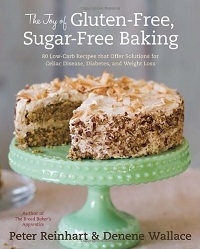 As a baker, wheat flour and sugar are two of the staples that I always have in my kitchen and use just about every day. There are many people out there, however, who can’t or don’t eat either of these things for either medical or health-weight reasons. Many books on gluten free baking put the emphasis on the health issues and not focusing on getting the best flavor or texture in the recipes. Other books simply try to mimic foods made with traditional flour and sugar with vague suggestions for substitutions. In The Joy of Gluten-Free, Sugar-Free Baking, every recipe is built from the ground up to create delicious products that stand on their own merits using alternative flours – such as almond, coconut, hazelnut, sesame seed and flaxseed, as well as flours made with beans and gluten-free grains – and alternative sweeteners, like Splenda and Stevia.
As a baker, wheat flour and sugar are two of the staples that I always have in my kitchen and use just about every day. There are many people out there, however, who can’t or don’t eat either of these things for either medical or health-weight reasons. Many books on gluten free baking put the emphasis on the health issues and not focusing on getting the best flavor or texture in the recipes. Other books simply try to mimic foods made with traditional flour and sugar with vague suggestions for substitutions. In The Joy of Gluten-Free, Sugar-Free Baking, every recipe is built from the ground up to create delicious products that stand on their own merits using alternative flours – such as almond, coconut, hazelnut, sesame seed and flaxseed, as well as flours made with beans and gluten-free grains – and alternative sweeteners, like Splenda and Stevia.
One of the authors of this book, Peter Reinhart, is well known as the author of some fabulous bread baking books, including The Bread Baker’s Apprentice and Artisan Breads Every Day. It is unusual to see an author and baker covering both traditional baking and gluten free baking, but I have had great results with Reinhart’s recipes in the past and found that the attention to detail from his other books carried over into these recipes. His contribution also means that this book has a lot of real bread recipes in it, from dinner rolls to breadsticks.
In addition to the breads, the recipes in this book range from pancakes and scones to cakes and pies. There is a lot of emphasis on the techniques used in making the batters and doughs, including some tips in the introduction about using the texture of a dough to tell how to work with it for the best results. Most of the recipes also come with handy suggestions that will help ensure that you get the best results possible with each one. Aside from the sweeteners, the recipes don’t call for commercial products like gluten free all purpose flour mixtures, and rely on components that you can easily make or put together yourself, such as blends of different nut flours. There are plenty of tips on making these flours, too, and once you have the fundamentals of the recipes in this book you will probably find it easy to use the techniques to create your own variations.






What do you think?